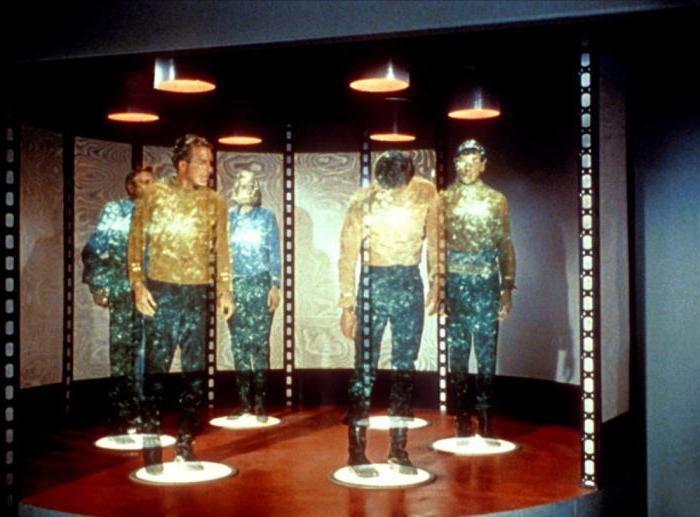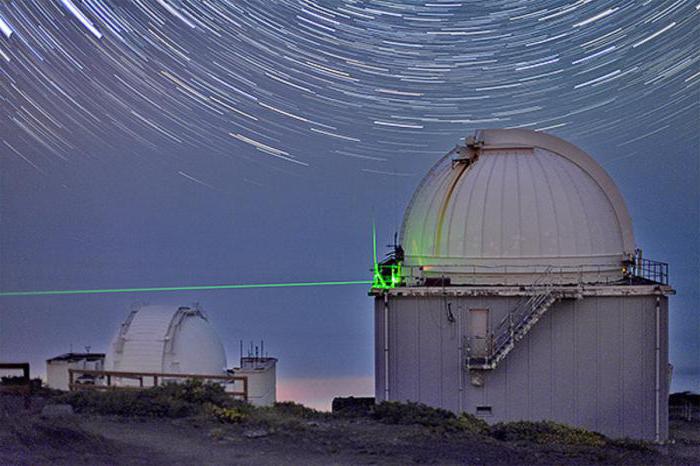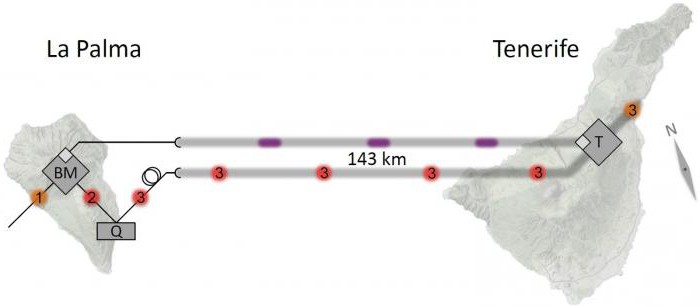Quantum teleportation is one of the most important protocols in quantum information. Based on the physical resource of entanglement, it serves as the main element of various information problems and represents an important component of quantum technologies, playing a key role in the further development of quantum computing, networks, and communication.
From science fiction to the discovery of scientists
More than two decades have passed since the discovery of quantum teleportation, which is perhaps one of the most interesting and exciting consequences of the "oddity" of quantum mechanics. Before these great discoveries were made, this idea belonged to the field of science fiction. The term “teleportation”, first coined in 1931 by Charles H. Fort, has since been used to refer to the process by which bodies and objects are transferred from one place to another without actually covering the distance between them.
In 1993, an article was published describing the protocol of quantum information, called “quantum teleportation,” which shared several of the features listed above. In it, the unknown state of the physical system is measured and subsequently reproduced or “reassembled” in a remote place (the physical elements of the original system remain in the place of transmission). This process requires classical means of communication and excludes superlight communication. It requires a resource of entanglement. In fact, teleportation can be considered as a protocol of quantum information, which most clearly demonstrates the nature of entanglement: without its presence, such a state of transmission would not be possible within the framework of the laws that describe quantum mechanics.

Teleportation plays an active role in the development of information science. On the one hand, this is a conceptual protocol that plays a decisive role in the development of the formal quantum theory of information, and on the other, it is a fundamental component of many technologies. A quantum repeater is a key element of long distance communication. Teleportation of quantum switches, measurement-based computing, and quantum networks are all derivatives of it. It is also used as a simple tool for studying “extreme” physics related to time curves and the evaporation of black holes.
Today, quantum teleportation has been confirmed in laboratories around the world using many different substrates and technologies, including photonic qubits, nuclear magnetic resonance, optical modes, groups of atoms, trapped atoms and semiconductor systems. Outstanding results have been achieved in the field of teleportation ranges, experiments with satellites are coming. In addition, attempts to scale to more complex systems have begun.
Teleporting Qubits
Quantum teleportation was first described for two-tier systems, the so-called qubits. The protocol considers two remote parties called Alice and Bob, which share 2 qubits, A and B, in a pure entangled state, also called the Bell pair. At the input, Alice is given another qubit a, whose state ρ is unknown. She then performs a joint quantum measurement called Bell Detection. It transfers a and A to one of Bell's four states. As a result, the state of Alice's input qubit during measurement disappears, and Bob's qubit B is simultaneously projected onto P † k ρP k . At the last stage of the protocol, Alice passes the classical result of her measurement to Bob, who uses the Pauli operator P k to restore the original ρ.
The initial state of Alice's qubit is considered unknown, since otherwise the protocol reduces to its remote measurement. In addition, it itself can be part of a larger composite system shared with a third party (in this case, successful teleportation requires the reproduction of all correlations with this third party).

A typical experiment in quantum teleportation takes the initial state pure and belonging to a limited alphabet, for example, the six poles of the Bloch sphere. In the presence of decoherence, the quality of the reconstructed state can be quantified by the teleportation accuracy F ∈ [0, 1]. This is the accuracy between the states of Alice and Bob, averaged over all the Bell detection results and the original alphabet. At low accuracy values, there are methods that allow imperfect teleportation without using an intricate resource. For example, Alice can directly measure her initial state by sending results to Bob to prepare the resulting state. This measurement-training strategy is called "classic teleportation." It has a maximum accuracy of F class = 2/3 for an arbitrary input state, which is equivalent to the alphabet of mutually unbiased states, such as six poles of the Bloch sphere.
Thus, a clear sign of the use of quantum resources is the accuracy value F> F class .
Not a single qubit
According to quantum physics, teleportation is not limited to qubits, it can include multidimensional systems. For each final measurement of d, an ideal teleportation scheme can be formulated using the basis of maximally entangled state vectors, which can be obtained from a given maximally entangled state and the basis {U k } of unitary operators satisfying tr (U † j U k ) = dδ j, k . Such a protocol can be constructed for any finite-dimensional Hilbert space of the so-called. discrete-variable systems.
In addition, quantum teleportation can also extend to systems with infinite-dimensional Hilbert space, called continuously variable systems. As a rule, they are realized by optical bosonic modes, the electric field of which can be described by quadrature operators.
Speed and uncertainty principle
What is the speed of quantum teleportation? Information is transmitted at a speed similar to the transmission rate of the same amount of classical - possibly at the speed of light. Theoretically, it can be used in a way that classical cannot — for example, in quantum computing, where data is available only to the recipient.
Does quantum teleportation violate the uncertainty principle? In the past, the idea of teleportation was not taken very seriously by scientists, because it was believed that it violates the principle that prohibits any measurement or scanning process from extracting all the information of an atom or other object. In accordance with the uncertainty principle, the more accurately an object is scanned, the more it is affected by the scanning process until a point is reached when the initial state of the object is violated to such an extent that it will no longer be possible to obtain enough information to create an exact copy. This sounds convincing: if a person cannot extract information from an object to create a perfect copy, then the latter cannot be made.
Quantum Teleportation for Dummies
But six scientists (Charles Bennett, Gilles Brassard, Claude Crepeau, Richard Jos, Asher Perez and William Wooters) found a way around this logic using the famous and paradoxical feature of quantum mechanics, known as the Einstein-Podolsky-Rosen effect. They found a way to scan part of the information of the teleported object A, and transfer the rest of the unverified part through the mentioned effect to another object C, who had never been in contact with A.
In the future, by applying to C an effect depending on the scanned information, one can enter C into state A before scanning. A itself is no longer in that state, since it has been completely changed by the scanning process, so what has been achieved is teleportation, not replication.
Fight for range
- The first quantum teleportation was carried out in 1997 almost simultaneously by scientists from the University of Innsbruck and the University of Rome. During the experiment, the initial photon with polarization and one of the pair of entangled photons were changed so that the second photon received the polarization of the original. In this case, both photons were at a distance from each other.
- In 2012, another quantum teleportation (China, University of Science and Technology) took place through an alpine lake at a distance of 97 km. A team of scientists from Shanghai, led by Huang Yin, managed to develop a guiding mechanism that allowed them to precisely aim the beam.
- In September of that year, a record quantum teleportation of 143 km was carried out. Austrian scientists from the Austrian Academy of Sciences and the University of Vienna, led by Anton Zeilinger, successfully transferred quantum states between the two Canary Islands of La Palma and Tenerife. The experiment used two optical communication lines in open space, quantum and classical, a frequency-uncorrelated polarized entangled pair of photon sources, ultra-low noise single-photon detectors, and coupled clock synchronization.
- In 2015, researchers from the American National Institute of Standards and Technology first transmitted information over a distance of more than 100 km via optical fiber. This was made possible thanks to single-photon detectors created at the Institute using superconducting nanowires made of molybdenum silicide.

It is clear that an ideal quantum system or technology does not yet exist and the great discoveries of the future are yet to come. Nevertheless, you can try to identify possible candidates in specific areas of teleportation applications. Their appropriate hybridization, subject to a compatible base and methods, can provide the most promising future for quantum teleportation and its applications.
Short distances
Teleportation to short distances (up to 1 m) as a subsystem of quantum computing is promising on semiconductor devices, the best of which is the QED scheme. In particular, superconducting transmon qubits can guarantee deterministic and high-precision teleportation on a chip. They also allow real-time direct feed, which looks problematic on photon chips. In addition, they provide a more scalable architecture and better integration of existing technologies compared to previous approaches such as trapped ions. At present, the only drawback of these systems, apparently, is their limited coherence time (<100 μs). This problem can be solved by integrating the QED scheme with semiconductor spin-ensemble memory cells (with nitrogen-substituted vacancies or rare-earth doped crystals), which can provide a long coherence time for quantum data storage. Currently, this implementation is the subject of great efforts of the scientific community.
City connection
Teleportation communications on a city scale (several kilometers) could be developed using optical modes. With sufficiently low losses, these systems provide high speeds and bandwidth. They can be expanded from desktop implementations to medium-range systems operating via ether or fiber, with possible integration with ensemble quantum memory. Farther distances, but with lower speeds, can be achieved using a hybrid approach or by developing good repeaters based on non-Gaussian processes.
Long distance communication
Long-distance quantum teleportation (over 100 km) is an active area, but still suffers from an open problem. Polarization qubits are the best carriers for low-speed teleportation over long fiber-optic communication lines and over the air, but the protocol is currently probabilistic due to incomplete Bell detection.
Although probabilistic teleportation and entanglement are acceptable for tasks such as entanglement distillation and quantum cryptography, this is clearly different from communication in which the input information must be completely stored.
If we accept this probabilistic nature, then satellite implementations are within the reach of modern technology. In addition to the integration of tracking methods, the main problem is the high losses caused by beam spreading. This can be overcome in a configuration where entanglement is distributed from the satellite to ground-based telescopes with a large aperture. Assuming a satellite aperture of 20 cm at 600 km altitude and a telescope's 1st diaphragm on the ground, we can expect about 75 dB of downlink channel loss, which is less than 80 dB of ground level loss. Earth-satellite or satellite-satellite implementations are more complex.
Quantum memory
The future use of teleportation as part of a scalable network directly depends on its integration with quantum memory. The latter should have an excellent, in terms of conversion efficiency, “radiation-matter” interface, write and read accuracy, storage time and bandwidth, high speed and storage capacity. First of all, this will allow the use of repeaters to expand communication far beyond the scope of direct transmission using error correction codes. The development of good quantum memory would allow not only to distribute entanglement over the network and teleport communication, but also to coherently process the stored information. Ultimately, it can turn the network into a world-wide distributed quantum computer or the foundation for the future of the quantum Internet.
Promising developments
Atomic ensembles have traditionally been considered attractive because of their efficient light-matter conversion and their millisecond storage times, which can reach the 100 ms needed to transmit light globally. Nevertheless, more promising developments are expected today on the basis of semiconductor systems, where an excellent spin-ensemble quantum memory is directly integrated with the scalable architecture of the QED scheme. This memory can not only extend the coherence time of the QED circuit, but also provide an optical-microwave interface for the interconversion of optical-telecommunication and chip microwave photons.
Thus, the future discoveries of scientists in the field of quantum Internet are likely to be based on long-distance optical communication coupled with semiconductor nodes for processing quantum information.